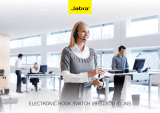
2.4.2 Hookswitch selection
The GN9350e enables you to answer and end calls remotely by using the GN1000 RHL, or its
built-in electronic hookswitch (EHS) modes. EHS is only possible on certain telephone systems.
In order to determine which telephones have the EHS feature enabled, please refer to our website
www.jabra.com. Please also refer to your telephone´s user manual for clarification.
4 modes are available
GN RHL (Default) non-EHS; works with the GN1000 RHL
DHSG e.g. Siemens, Elmeg, Cisco, Avaya, and Polycom desk telephones
AEI e.g. with Tenovis desk telephones
MSH e.g. with Alcatel desk telephones
Note: By default, the GN9350e is set to the RHL interface, which also is the correct setting if you manually operate your
handset when answering/ending calls as described in the Guide for basic set-up and use.
To select the appropriate interface:
1. Use
34
to locate the hookswitch selection menu
on base display.
2. Use
5
6 to select one of the 4 interfaces from the menu.
3. Press OK to confirm the interface.
Note: To use the DHSG, AEI or MSH function, connect the connection cord
(accessory) to your desk telephone and the AUX port of the GN9350e.
2.4.3 Range/power selection
Your headset offers 3 range/power modes (Normal, Low and
Very Low). The Normal mode is ideal for most users. However,
if you experience interference from other communication devices during your calls, you may
want to switch to the Low or Very Low modes. Changing to Low or Very Low power modes will
reduce the range of your headset.
Power mode Range* DECT Range* US DECT
Normal (Default) Up to 120 m Up to 400 ft
Low Up to 60 m Up to 200 ft
Very Low (V. low) Up to 25 m Up to 80 ft
* In typical office environment
Note: The Normal power mode is the default setting.
To change the range/power mode:
1. Use
34
to locate the range/power mode menu on base display.
2. Use
5
6 to select one of the 3 modes from the menu.
3. Press OK to confirm the new mode.
2.4.4 Sound mode selection
This menu is split into two sections: “Treble/Normal/Bass” and “Fixed/Switch”. These two sections
are separated by a blank line. It is possible to choose one mode in each of the two sections.
Your headset offers 3 treble/bass modes (Treble, Normal and Bass). You can change these to suit
your personal preferences or needs, and seperately determine the USB sound quality.
Sound mode Effect Benefits
Treble Accentuates high tones Ideal for users with slight high-
frequency hearing loss
Normal (Default) Accentuates all tones evenly Ideal for all users
Bass Accentuates lower tones Ideal for users preferring a bass-rich
sound
Sound mode Effect Benefits
Fixed Speech quality in headset loudspeaker as known
from traditional telephones (narrowband)
- Improved talk time in USB mode
- Faster radio link
- More units in a given area
Switch (Default) Automatically switches between wideband or
narrowband sound quality. In conference call mode,
automatic switching is disabled.
Enhanced USB sound quality
Note: The Normal mode is the default setting. For high density deployments, or if there are difficulties or delay
acquiring a radio link, it is recommended to change sound mode from ‘switch’ to ‘fixed’.
On the GN9350e, CARB+ can be enabled to offer an additional +6 dB of transmit gain (typically
used with carbon based phones).
Sound mode Effect Benefits
CARB+ Additional + 6dB transmit gain Higher transmit volume
To change the sound mode:
1. Use
34
to locate the sound mode menu on base display.
2. Use
5
6 to select one of the 3 modes from the menu, and choose between
fixed/switched from the menu.
3. Press OK to confirm the setting.
6 7















